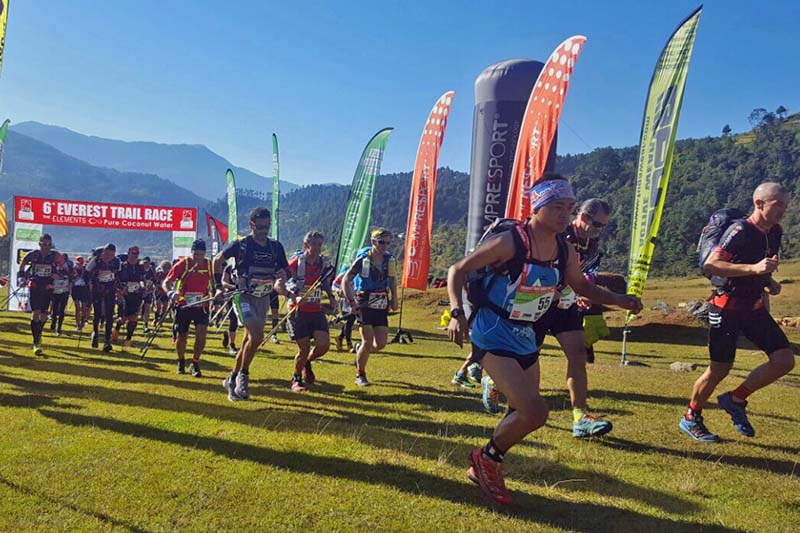Nepal’s Sherpa takes lead in toughest Everest Trail Race
KATHMANDU: The world’s toughest high-altitude trail race has begun from Jiri of Dolakha district on Thursday morning.
At least 45 persons including 10 women took part in the sixth edition of the Everest Trail Race which was organised to preserve the route used by Tenzing Norge Sherpa and Edmund Hillary while making the first ascent to the Mt Everest in 1953, the organisers said.
Pasang Lama Sherpa of Salleri, Solukhumbu took a lead among 45 ultra runners from 10 countries as Sherpa reached Bamti Bhandar, the first section of the trail, in two hours, 40 minutes and five seconds, according to Kami Sherpa, Managing Director at the Annapurna Treks and Expedition Pvt Ltd.
Sherpa is the only Nepali participant while others were from Spain, UK, Portugal, South Africa, Slovenia, Germany and Italy, he added.
Pasanng Sherpa, the ETR Nepal Manager, informed that UK’s Morgan Casey and Capo Soler Miquel from Spain reached the first point of the trail in two hours 42 minutes and 30 seconds while Spanish runner Soler Joan made it to the third position reaching Bamti Bhandar in two hours, 48 minutes and 54 seconds.
In women’s category, Jennifer Hill (UK), Andreaza Sperle (Slovenia) and Janni Canham (UK) made it to top three reaching Bamti Bhandar in three hours, 48 minutes; three hours 54 minutes and four hours 24 minutes respectively.
The runners must cover a distance of approximately 160 km, with a difference in altitude of 2,000 to 4,100 meters in six days.
“It is divided into six stages with stop points Bamti Bhandar (22 km), Jase Bhanjyang (24 km), Kharikhola (37 km), Phakding (28 km), Tyangboche (20 km) and Lukla (30 km), respectively. The daily difference in altitude goes from 3,200 to 6,600 metres,” Sherpa said.
The race takes place, as in the five previous editions, in the Khumbu Valley between 10 and 15 of November. The race will resume in Bamti Bhandar and will end in Jase Bhanjyang on Friday as runners will have to exceed a total of 5,282 metres of altitude, he added.
“Runners will reach the highest point of the entire ETR, the Pikey Peak (4,068 m), from which it can be seen the most spectacular peaks in the world, like Mt Everest, Mt Lhotse and Mt Makalu, among others.”
The event always released the tears of joy, relief and excitement among the participants, their companions and the organising members as the participants passed the finishing line banner after six grueling days on the most incredible trails, Sherpa recounted.
According to Jordi Abad, ETR’s General Director, the ETR is a race with a free style.
All participants have passed technical and medical checks before moving to the start of the race, he added.
“Medical teams have their permanent presence at the start and end points of the stage while other members of the medical team will also be at some checkpoints or on the path to monitor the health status of the runners of the one of the world’s toughest high-altitude multi-day ultras,” he informed.
As in the past, the top three athletes in both men and women categories will receive Euro 1,000, 750 and 250 respectively.
In 2015, Nepal’s Bhim Gurung (Adeaventura-Annapurna Treks) had won the race in men’s category covering all six stages in 20 hours and 24 minutes while Catalan Anna Comet had won the race in women’s category in 25 hours and 44 minutes.






